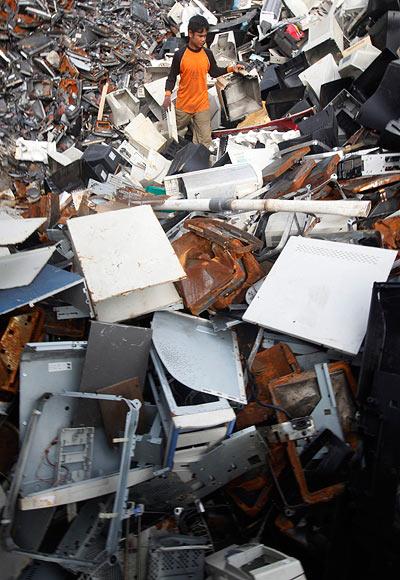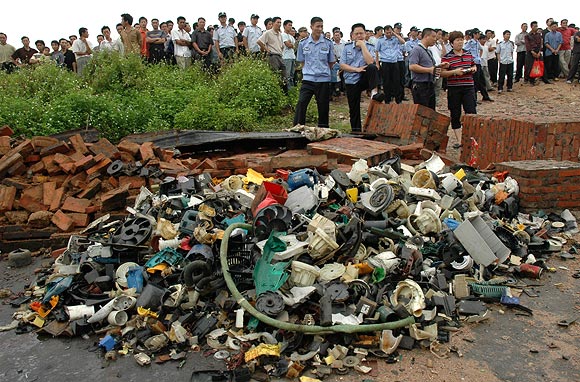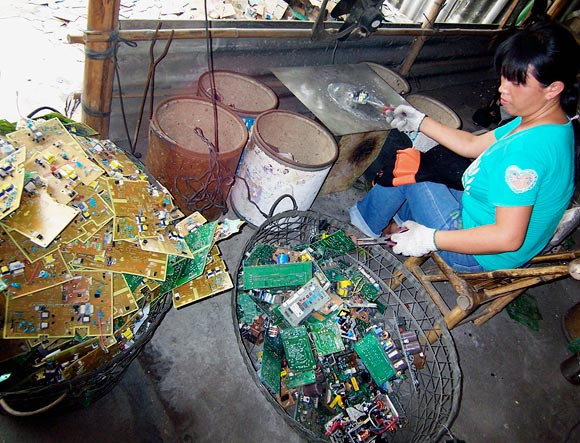Photographs: Dadang Tri/Reuters
Electronic waste, if not disposed of carefully, can cause cancer, infertility and severe mental dysfunction apart from polluting the environment.
Electronic waste, if not disposed of carefully, can cause cancer, infertility, severe mental dysfunction apart from polluting the environment.
We often talk about how fast technology progresses. One minute, a Samsung Galaxy Note seems like the most powerful device on the market. More than a year later, the Samsung Galaxy S4 releases, bringing a 1080p display, eight core CPU and oodles of battery life.
In China alone for the past quarter, the total number of smartphones sold by Samsung and Apple totals 18.6 million units -- and that’s a nation still on the rise. The trend is not just limited to smartphones, nor is it a recent one.
As TV technology constantly improves over the decades, consumers upgrade from CRTs to LCDs and from LCDs to HDTVs. The latest addition -- 3D displays -- are now playing second fiddle to Ultra HD displays, which promise to bring a greater clarity to pictures than ever before.
The same trend has been seen when consumers upgrade their computers. Graphic cards, CPUs, RAM, motherboards -- even keyboards, mice and cabinets -- are constantly being upgraded. So the question then is: What happens to the old technology when we no longer need it?
This discarded technology makes up electronic waste or e-Waste, which is becoming one of the highest growing sources of pollution estimated to increase by 500 per cent over the next decade.
Your discarded smartphones, TVs, computers can harm YOU!
Photographs: Stringer Shanghai/Reuters
What is e-Waste?
The term e-Waste refers to discarded electronics that consumers no longer use. The definition is still tenuous, as some use it to refer to discarded computers that have been reused and refurbished, while some refer to e-Waste as computers that are no longer used for their intended purpose. Despite the lack in a clear definition, the threat that e-Waste presents is very clear.
For creating different kinds of electronics, there are many different metals and materials used (at last count, a maximum of 60 elements can be found in some electronics). Some of those include useful metals like copper, aluminium, etc. Electronics can actually be stripped down and their components used for different purposes. Even the plastic encasing the components can serve as some purpose, and if not, it can be safely disposed.
However, along with useful metals, there are many hazardous materials present in electronics that are unsafe to dispose of normally. These include lead and cadmium. Some of them may even be radioactive in nature and serve as a cancer-causing agent, like americium which is used in smoke alarms. Mercury is often found in fluorescent tubes, and can affect the environment in numerous ways such as causing death in animals and reduced fertility.
But the most hazardous electronic to recycle are CRT (Cathode Ray Tube) monitors. This is primarily due to high concentrations of lead and phosphorous, which can both be dangerous to the environment and to people. Up to 8 pounds of lead may be present in a CRT monitor, which can be enough to cause severe mental dysfunction, leading to reduced IQ, behavioural problems and hyperactivity, among others. It is also the hardest electronic to recycle.
Reader Invite
Are you a gadget/gaming wizard/afficianado? Would you like to write on gadgets, gaming, the Internet, software technologies, OSs and the works for us? Send us a sample of your writing to gadgetsandgaming@rediffmail.com with the subject as 'I'm a tech wizard/afficianado' and we will get in touch with you.
Your discarded smartphones, TVs, computers can harm YOU!
Photographs: China Daily/Reuters
Landfills and recycling e-Waste
According to studies, the amount of e-Waste produced each year is estimated to be 50 million tons. Of these, only about 15 to 20 per cent is recycled with the remainder either being dumped into a landfill or incinerated to a crisp. The faster technology proceeds, the more amount of e-Waste produced. As people upgrade their smartphones and dispose of their old ones -- the rate of which is increasing as fast as more upgrades are made -- the greater the amount of e-Waste generated. The United States alone has more than 70 per cent of the metals in its landfills coming from electronics.
China, as mentioned above, is already a fairly strong consumer of electronics. As a result, it produces about 2.3 million tons of e-Waste despite banning imports. Guiyu in China is referred to as the “e-Waste capital of the world”, which uses more than 150,000 workers a day to disassemble and recycle electronics. However, there have been issues of occupational hazards such as the effect of poisonous materials on the workers, lack of proper disposal of electronics, and even water pollution happening.
For all the agreements and disagreements on e-Waste, there is a concerted effort being made to recycle old electronics. Many major retailers such as Staples and Best Buy ofer to take electronics, even those that haven’t been purchased from the outlet, for recycling. Organisations such as the World Reuse, Repair and Recycling Association work to improve recycling techniques, while others such as E-Cycling Central list recyclers by state and help consumers find places where they may be able to recycle their old devices.
Recycling of e-Waste as such should be encouraged because it brings many useful materials back for reuse.
Elements, such as metals, are not unlimited in the environment. The copper from discarded electronics can be smelted down and reused in the manufacture of transistors and integrated circuits, which are core component of CPUs. Glass, plastic and even gold and silver all have their uses even if the electronic item is no longer being used. Even the lead from CRT monitors can be reused for car batteries or be used as a chemical agent in other processes.
Reader Invite
Are you a gadget/gaming wizard/afficianado? Would you like to write on gadgets, gaming, the Internet, software technologies, OSs and the works for us? Send us a sample of your writing to gadgetsandgaming@rediffmail.com with the subject as 'I'm a tech wizard/afficianado' and we will get in touch with you.
Your discarded smartphones, TVs, computers can harm YOU!
Photographs: Kitty Bu/Reuters
E-future planning
It is easy to blame smartphones and computers for the rise of e-Waste. However, technology is being employed everywhere we look. It must be constantly maintained and when it breaks down, it must be disposed of and replaced. This is true even of printer cartridges, which are decidedly lacking in any hazardous materials or useful metals.
Going forward, the solution lies in improving recycling techniques and processes to ensure that both the materials in question are properly disposed of and that the environment is not suffering from it. The individuals in charge of recycling must also take measures to safeguard themselves in the long run, improving their methods and taking caution when required.
The progress of technology cannot be suddenly stopped so e-Waste will continue to be produced. But at the very least, a cycle of efficiency can be created and maintained to ensure the safety of our future.
Reader Invite
Are you a gadget/gaming wizard/afficianado? Would you like to write on gadgets, gaming, the Internet, software technologies, OSs and the works for us? Send us a sample of your writing to gadgetsandgaming@rediffmail.com with the subject as 'I'm a tech wizard/afficianado' and we will get in touch with you.






Comment
article